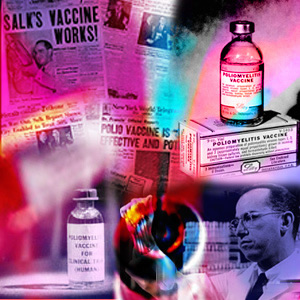
 |
Vaccine |
| HOME |
 |

A vaccine is a shot that helps your body build protection against disease. The polio vaccine is a shot of medicine that helps protect people from getting the disease polio. Polio was a very common disease, spread through human-to-human contact, usually due to contaminated food or water. Before the 1950s, the disease caused thousands of people to become paralyzed or die every year. One famous polio victim was President Franklin D. Roosevelt, who contracted the disease in 1921 and was paralyzed from the waist down. Attempts to discover a polio vaccine had begun in the early 1900s. However, early attempts failed, partly because researchers did not know there was more than one virus that caused the disease. What they did know was that babies were frequently exposed to polioviruses because sanitation conditions were poor. Breast-fed infants did not contract the disease because their mother's antibodies were passed on to them through the motherís milk. The babies then developed their own antibodies to the virus. Later, when sanitation improved, infants were no longer exposed to the virus at an age when they were protected, so their bodies did not develop natural antibodies. Consequently, when they were exposed to the virus in later childhood and adulthood, they were at risk to contract polio. The first effective polio vaccine was developed by Jonas Salk in 1952. However, it was the oral vaccine developed by Albert Sabin eight years later that was used for the first mass inoculations. World-wide immunization efforts have nearly wiped out all new cases of polio. Since the 1950s, other vaccines have been developed, such as smallpox, influenza, hepatitis A and B, measles, mumps, and rubella. Scientists are currently working on new vaccines to prevent diseases like cancer and HIV/AIDS. |
|
|